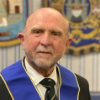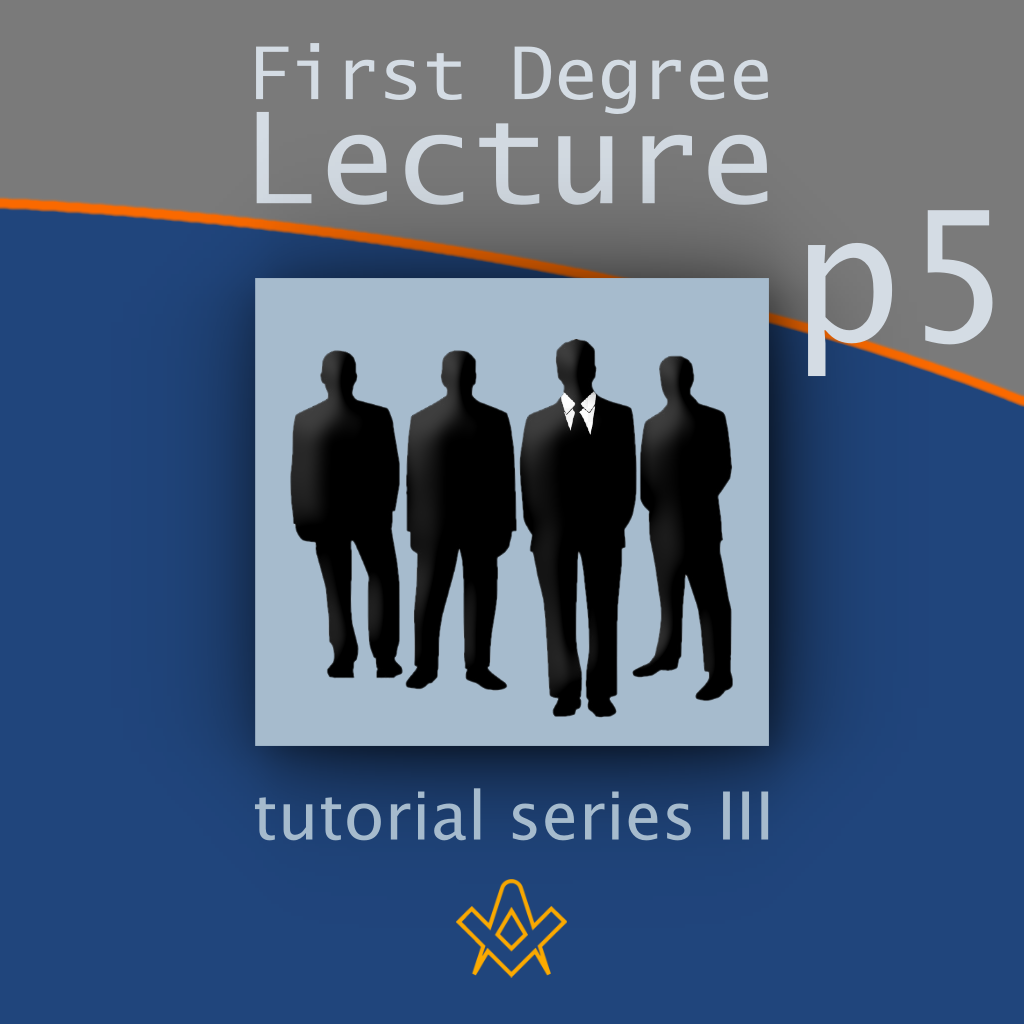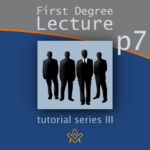Mentor’s Notes – Learning Outcomes
By the end of this tutorial the learner will be able to:
• Identify and explain the : Ornaments, Furniture and Jewels of a Freemasons Lodge.
The First Degree Lecture, Section Five, by William Preston.
Video Presentation
In Section Four Preston gave an explanation of the ritual around the Lodge itself, its position, how it is supported and its representation. Section Five concentrates on the interior of the Lodge and the moralisation on the Ornaments, Furniture and Jewels. Preston gives a wonderful explanation of each. Enjoy.
Q – Of what is the interior of a Freemason’s Lodge composed?
A – Ornaments, Furniture, and jewels.
(NOTE: In architecture an ornament is decoration used to embellish parts of a building.
Furniture are moveable articles that are used to make a room or building suitable for living or working in. Jewels are “treasured possessions” usually of precious metal or stones.)
Q – Name the Ornaments.
A – The Mosaic Pavement, the Blazing Star, and the Indented or Tessellated Border.
Q – Their situations?
A -The Mosaic Pavement is the beautiful flooring of the Lodge; the Blazing Star the glory in the centre; and the Indented or Tessellated Border the skirtwork round the same.
Q – I will thank you to moralise them.
A – The Mosaic Pavement may justly be deemed the beautiful flooring of a Freemason’s Lodge, by reason of its being variegated and chequered. This points out the diversity of objects which decorate and adorn the creation, the animate as well as the inanimate parts thereof.
The Blazing Star, or glory in the centre, refers us to the Sun, which enlightens the earth, and by its benign influence dispenses its blessings to mankind in general.
The Indented or Tessellated Border refers us to the Planets, which, in their various revolutions form a beautiful border or skirtwork round that grand luminary, the Sun, as the other does round that of a Freemason’s Lodge.Q – Why was Mosaic work introduced into Freemasonry?
A – As the steps of man are trod in the various and uncertain incidents of life, and his days are variegated and chequered by a strange contrariety of events, his passage through this existence, though sometime attended by prosperous circumstances, is often beset by a multitude of evils; hence is our Lodge furnished with Mosaic work, to point out the uncertainty of all things here on earth.
Today we may travel in prosperity tomorrow we may totter on the uneven path of weakness, temptation, and adversity.Then while such emblems are before us, we are morally instructed not to boast of anything but to give heed to our ways, to walk uprightly and with humility before God, there being no station in life on which pride can with stability be founded; for though some are born to more elevated situations than others, yet, when in the grave, we are all on the level, death destroying all distinctions; and while our feet tread on this Mosaic work, let our ideas recur to the original whence we copy; let us, as good men and Masons, act as the dictates of reason prompt us, to practice charity, maintain harmony, and endeavour to live in unity and brotherly love.
(NOTE: Throughout our Masonic teachings, humility and harmony run as a thread. From our entrance into the lodge in humble clothing all the way through to reflections of our lives in the Third Degree. There will always be greater and lesser persons than yourselves, so humility is a signature of a Freemason.
Q – Name the furniture of the Lodge.
A – The Volume of the Sacred Law, the Compasses, and Square.
Q – Their uses?
A – The Sacred Words are to rule and govern our faith, on them we Obligate our candidates for Freemasonry. So are the Compasses and Square, when united, to regulate our lives and actions.
Q – From whom is the first derived, and to whom do the other two more properly belong?
A – The Volume is derived from God to man in general; the Compasses belong to the Grand Master in particular; and the Square to the whole Craft.
Q – Why the Sacred Volume from God to man in general?
A – Because the Almighty has been pleased to reveal more of His Divine will in that Holy Book than He has by any other means.
Q – Why the Compasses to the Grand Master in particular?
A – That, being the chief instrument for use of in the formation of Architectural plans and designs, is peculiarly appropriated to the Grand Master, as an emblem of his dignity; he being the Chief, Head, and Governor of the Craft.
(NOTE: The Grand Master and Provincial Grand Masters have a pair of compasses appended to their collars. He / She is the chief administrator of their respective areas.
‘In the teachings of Freemasonry, the compasses are symbolically employed to draw a boundary line around our desires to avoid overindulgence and maintain moderation, the foundation of morality and wisdom.’ ‘Behind the Masonic Symbols’, The Grand Lodge of Ohio.)
Q – And why the Square to the whole Craft?
A – The Craft being Obligated within the Square are consequently bound to act thereon.
(NOTE: The Square you will find on the Worshipful Master’s Collar to show his/her authority as the chief administrator within the Lodge.
‘In Freemasonry, this symbol is used to teach lessons of morality. The notion that being “square” in your actions implies being honest and fair.’ ‘Behind the Masonic Symbols’. The Grand Lodge of Ohio.)
Q – Before our ancient brethren had the benefit of such regular, well-formed, constituted Lodges as we now enjoy, where did they assemble?
A – On high hills and in low vales, even in the valley of Jehoshaphat, and many other secret places.
(NOTE: The Valley of Jehoshaphat is a narrow piece of land between Temple Mount and the Mount of Olives. A religious site in East Jerusalem. In Hebrew ‘yehoshafat’ means ‘God has judged’. It is here that the events of ‘Judgement Day’ are said will take place. (Joel 3:12) Also a reference to the Symbolic Lecture in the Holy Royal Arch.)
Q – Why so high, low, and very secret?
A – The better to observe all who might ascend or descend; that if a stranger should approach, the Tyler might give timely notice to the Master to hail the brethren, close the Lodge, put by the jewels, and thereby prevent any of our Masonic secrets from being illegally obtained.
Q – You speak of jewels, and seem careful of them; how many are there in the Lodge?
A – Three movable, and three immovable,
Q – Name the movable jewels?
A – The Square, Level, and Plumb Rule.
Q – Their uses?
A – The Square is to try, and adjust rectangular corners of buildings, and assist in bringing rude matter into due form; the Level to lay levels, and prove horizontals; the Plumb Rule to try, and adjust uprights, whiIe fixing them on their proper bases.
Q – It would appear from this that they are mere mechanical tools; why do you call them jewels?
A – On account of their moral tendency, which renders them jewels of inestimable value.
Q – I will thank you to moralise them.
A – The Square teaches us to regulate our lives and actions according to the Masonic line and rule, and to harmonise our conduct in this life, so as to render us acceptable to that Divine Being from whom all goodness springs, and to whom we must give an account of all our actions.
(NOTE: To live a virtuous and respected life as a man of faith and a Freemason.)
The Level demonstrates that we are all sprung from the same stock, partakers of the same nature, and sharers in the same hope;
and although distinctions among men are necessary to preserve subordination, yet ought no eminence of situation make us forget that we are Brothers;
for he who is placed on the lowest spoke of fortune’s wheel is equally entitled to our regard; as a time will come and the wisest of us knows not how soon when all distinctions, save those of goodness and virtue, shall cease, and Death, the grand leveller of all human greatness, reduce us to the same state.
(NOTE: To treat all men with kindness and respect.)
The infallible Plumb Rule, which, like Jacob’s ladder, connects Heaven and Earth, is the criterion of rectitude and truth.
It teaches us to walk justly and uprightly before God and man; neither turning to the right nor left from the paths of virtue.
Not to be an enthusiast, persecutor, or slanderer of religion; neither bending towards avarice, injustice, malice, revenge, nor the envy and contempt of mankind, but giving up every selfish propensity which might injure others.
To steer the bark of this life over the seas of passion, without quitting the helm of rectitude, is the highest perfection to which human nature can attain, and as the builder raises his column by the level and perpendicular, so ought every Mason to conduct himself towards this world;
to observe a due medium between avarice and profusion; to hold the scales of justice with equal poise; to make his passions and prejudices coincide with the just line of his conduct; and in all his pursuits to have Eternity in view.
(NOTES: To walk this earth in a just and upright manner.)
Thus the Square teaches morality, the Level equality, and the Plumb Rule justness and uprightness of life and actions.
(NOTES: This answer is the lecture of the Second Degree Working Tools.)
Q – Why are they called movable jewels?
A – Because they are worn by the Master and his Wardens, and are transferable to their successors on nights of Installation.
Q – What is the Master distinguished by?
A – The Square; and why, Worshipful Master?
W. M. – As it is by the assistance of the Square that rude matter is brought into due form, so it is by the Square conduct of the Master that animosities are made to subside should any unfortunately arise among the Brethren, that the business of Masonry may be conducted with harmony and decorum.
(NOTE: Rude matter being the imperfections of Masons. So by the ‘Square conduct’ of the Worshipful Master, that of being honest and fair in his dealings, there is harmony in the Lodge.)
Q – Brother Senior Warden, why are you distinguished by the Level?
S.W – That being an emblem of equality, points out the equal measures I am bound to pursue in conjunction with your Worshipful Master in the well ruling and governing of the Lodge.
(NOTE: To be fair to both parties in any dispute and supporting the Worshipful Master. ‘Equality’ a further precious commodity.)
Q – Brother Junior Warden, why are you distinguished by the Plumb Rule?
J.W – That being an emblem of uprightness, points out the integrity of the measures I am bound to pursue, in conjunction with your Worshipful Master and my Brother Senior Warden, in the well ruling and governing of the Lodge, particularly in the examination of visitors, lest through my neglect any unqualified person should gain admission to our assemblies, and the Brethren be thereby innocently led to violate their Obligations.
(NOTE: “Integrity of the measures”, being honest and having strong principles. Supporting the Worshipful Master and the Senior Warden. Not blindly but with integrity. ‘Integrity’ a third precious commodity.)
Q – Name the Immovable jewels?
A – The Tracing Board, the Rough and Perfect Ashlars.
Q – Their uses?
A – The Tracing Board is for the Master to lay lines and draw designs on; the Rough Ashlar for the Entered Apprentice to work, mark, and indent on; and the Perfect Ashlar for the experienced craftsman to try and adjust his jewels on.
Q – Why are these called Immovable jewels?
A – Because they lie open and Immovable in the Lodge for the Brethren to moralise on.
Q – There is a beautiful comparison between the immovable jewels and the furniture of the Lodge, which I will thank you for.
A – As the Tracing Board is for the Master to lay lines and draw designs on, the better to enable the Brethren to carry on the intended structure with regularity and propriety, so the Volume of the Sacred Law may justly be deemed the spiritual Tracing Board of the great Architect of the Universe, in which are laid down such Divine laws and moral plans, that were we conversant therein, and adherent thereto, would bring us to an ethereal mansion not made with hands, eternal in the Heavens.
(NOTE: The “structure” is man himself. So with the assistance of the Worshipful Master, who is guided by the VSL, a Mason will be able to make improvements in himself in order to be the best man he can be. A ‘plan and guide’, a fourth precious commodity.)
The Rough Ashlar is a stone, rough and unhewn, as taken from the quarry, until, by the industry and ingenuity of the workman, it is modelled, wrought into due form, and rendered fit for the intended structure.
This represents man in his infant or primitive state rough and unpolished as that stone, until by the kind care and attention of his parent or guardians, in giving him a liberal and virtuous education, his mind becomes cultivated, and he is thereby rendered a fit member of civilised society.
(NOTE: By such modelling of the stone by parents and guardians in the informative years he is ready to enter the civilised society of Freemasonry to continue to hone his personal imperfections. A ‘worthy man’, a fifth precious commodity.)
The Perfect Ashlar is a stone of a true die or square, fit only to be tried by the Square and Compasses. This represents man in the decline of years, after a regular well-spent life in acts of piety and virtue, which can no otherwise be tried and approved than by the Square of God’s Word, and the Compass of his own self-convincing conscience.
(NOTE: By following the dictates of the those ‘Three Great, Emblematical Lights’, the V.S.L., the Square and the Compasses, a freemason hopes to live a respected life represented by the Perfect Ashlar. The sixth precious commodity ‘a respected man’.)
Q – The Lodge being finished, furnished, and decorated, to whom do we dedicate it as a general Law?
A – God and His service.
Q – To whom next?
A – King Solomon.
Q – Why to King Solomon?
A – He being the first Prince who excelled in Masonry, and under whose royal patronage many of our Masonic mysteries obtained their first sanction.
Brethren, this ends the fifth section of the first lecture.
The past Grand Patrons of Masonry.
(NOTE: The First Temple was a structure that was moveable, a tent or tabernacle. The Second Temple was built of Stone a more permanent structure built to worship in and learn. The first Master builder in stone, within the settings of Masonic history, was therefore King Solomon, setting the standard for others to follow.)
Preston, through the ritual, has shown us how our Lodges are decorated and furnished. In some other jurisdictions outside that of the United Grand Lodge of England the moveable and immovable jewels are reversed.
In Section Six Preston expands on the virtues required of a Freemason.
Footnotes
References
The first Degree Lecture- William Preston
Valley of Jehoshaphat- Lonely Planet
Behind the Masonic Symbols – Grand Lodge of Ohio.
Article by: Stephen J. Goulding

Stephen was initiated into Freemasonry in 1978 in Tylney Lodge No. 5856 (UGLE). He was Master in 1989 & 2004.
He was Master of the Lodge of Union 38 (UGLE) in 2018. He is also a PZ in the Holy Royal Arch and PM in the Mark Degree.
Stephen served 30 years in the Metropolitan Police Service (London, England) before going into education in 2000, where he became a college lecturer and a mentor for both the college and the University of Greenwich (London, England). Now retired, he teaches Tai Chi and Qigong in the community.
Facebook: Steve Goulding-Tai Chi West Sussex–Chi at Chi
Recent Articles: The First Degree Lecture
masonic knowledge
to be a better citizen of the world
share the square with two brothers

click image to open email app on mobile device













